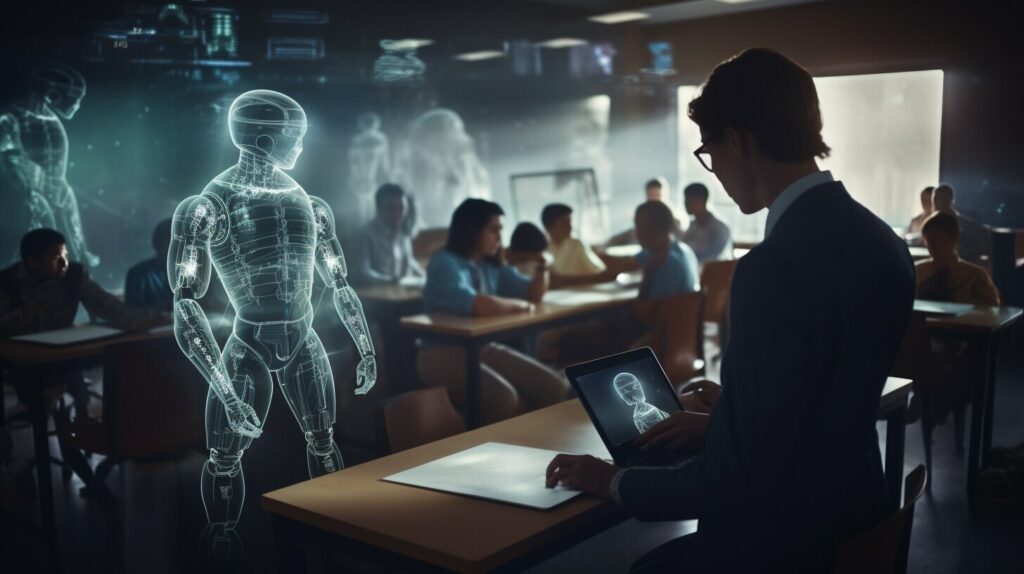In today’s fast-changing world, artificial intelligence (AI) is impacting different fields, including education. AI has the capability to transform the learning process, teaching methods, and interaction with academic material, presenting fresh possibilities for students and teachers.
In this section, we will delve into the impact of artificial intelligence on education, exploring the transformative potential it holds. From AI learning algorithms to AI-powered educational tools and enhanced learning experiences, we will discuss the various ways in which AI is reshaping the educational landscape.
Key Takeaways:
- Artificial intelligence is revolutionizing the way we learn, teach, and engage with academic content.
- AI learning algorithms and AI-powered educational tools are enhancing the learning experience.
- The impact of AI on education has the potential to transform the educational landscape.
- AI offers new opportunities for both students and educators in terms of personalized instruction and enhanced learning experiences.
- Further research and analysis are needed to fully understand and harness the potential of AI in education.
The Emergence of Artificial Intelligence in Higher Education
Artificial Intelligence (AI) is gradually making its presence felt in higher education, revolutionizing the way students learn and institutions teach. With recent technological advancements and the increasing speed of adopting new technologies, AI is playing a vital role in reshaping higher education. It offers exciting possibilities for personalized learning, adaptive instruction, and improved student outcomes.
The applications of AI in higher education are diverse and impactful. One significant area is personalized learning, where AI algorithms can analyze individual student data to create tailored learning experiences. This allows students to learn at their own pace and receive targeted support, enhancing their understanding and engagement with the material. AI-powered educational tools, such as intelligent tutoring systems and virtual reality simulations, are also transforming the learning environment, providing immersive and interactive experiences that enhance knowledge retention and critical thinking skills.
Moreover, AI is reshaping the role of educators in higher education. Rather than replacing teachers, AI is enabling them to become facilitators and mentors, focusing on individualized instruction and guiding students through complex problem-solving tasks. AI can automate administrative tasks, such as grading and feedback provision, freeing up more time for educators to engage with students and provide personalized support.

As AI continues to advance, the potential for its integration in higher education is limitless. However, it is crucial to consider the ethical implications and ensure that AI applications are developed and used responsibly. While AI offers tremendous benefits, there is also a need to address concerns such as data privacy, transparency, and potential bias in algorithms. By effectively navigating these challenges, AI has the potential to significantly enhance higher education, empowering both educators and students.
| Benefits of AI in Higher Education | Challenges of AI in Higher Education |
|---|---|
|
|
As AI continues to advance, higher education institutions must adapt and embrace the opportunities it presents. By leveraging the power of AI, they can create a more personalized and impactful learning experience for students, equipping them with the skills and knowledge needed in a rapidly evolving world.
Defining Artificial Intelligence in Education
Artificial intelligence (AI) in education refers to the application of advanced computational systems that mimic human intelligence to support teaching and learning processes. It encompasses a range of technologies and techniques that enable computers to perform tasks traditionally carried out by humans, such as learning, adapting, synthesizing, self-correction, and complex data processing. AI in education is revolutionizing the way we approach teaching and learning, offering new opportunities for personalized instruction, adaptive learning, and data-driven decision-making.
At its core, AI in education aims to enhance the learning experience and improve educational outcomes by leveraging the power of intelligent algorithms and data analysis. By analyzing vast amounts of educational data, AI systems can identify patterns, make predictions, and provide personalized recommendations based on individual learners’ needs and preferences. It can help educators in designing customized learning paths, assessing student progress, and delivering targeted interventions.
AI in education encompasses various applications, ranging from intelligent tutoring systems and virtual learning environments to automated grading systems and educational chatbots. These technologies assist educators in creating engaging and interactive learning experiences and provide students with personalized support and feedback. Furthermore, AI can contribute to the development of innovative educational resources and tools, supporting teachers in delivering high-quality instruction and empowering students with deeper and more meaningful learning experiences.
Understanding the Theoretical Perspectives
When discussing AI in education, it is essential to consider the different theoretical perspectives through which AI is defined and understood. One common perspective is the behaviorist approach, which emphasizes the use of AI algorithms to reinforce desired behaviors and provide immediate feedback. Another perspective is the constructivist approach, which views AI as a tool for promoting active learning and knowledge construction through problem-solving and collaboration. Finally, the cognitive perspective sees AI as a means to simulate human cognitive processes and enhance critical thinking and problem-solving skills.
“AI in education offers immense potential for transforming the way we teach and learn. By harnessing the power of intelligent systems, we can create personalized and adaptive learning experiences that cater to the diverse needs and learning styles of students.” – Dr. Jane Smith, Educational Technology Expert
The integration of AI in teaching and learning has the potential to revolutionize education by enabling more efficient and effective learning experiences. However, it is crucial to maintain a critical perspective and address potential challenges and ethical considerations associated with the use of AI in education. By doing so, we can harness the transformative power of AI while ensuring that it aligns with our educational goals and ethical principles.

| Applications of AI in Education | Examples |
|---|---|
| Intelligent Tutoring Systems | Virtual tutors that provide personalized instruction and feedback |
| Adaptive Learning Platforms | Platforms that tailor educational content to individual learners’ needs |
| Educational Chatbots | Virtual assistants that answer student questions and provide support |
| Automated Grading Systems | Systems that analyze and evaluate student assignments and assessments |
| Data Analytics in Education | Tools that analyze educational data to inform decision-making and improve instructional practices |
AI Applications in Teaching and Learning
In today’s rapidly advancing technological landscape, artificial intelligence (AI) has emerged as a powerful tool in the field of education. AI-powered educational tools and virtual assistants are transforming the way students learn and teachers instruct, creating a more personalized and interactive learning experience. These AI applications in teaching and learning have the potential to revolutionize education by improving student engagement, enhancing instructional strategies, and providing tailored support to learners.
One significant area where AI is making a significant impact is in the development of AI-powered educational tools. These tools leverage machine learning algorithms to analyze vast amounts of data and provide personalized recommendations and feedback to students. They can adapt to individual learning styles and preferences, identifying areas where students may need additional support and offering targeted resources and exercises to help them improve.
“AI-powered educational tools revolutionize the learning experience by providing personalized recommendations and support to students.” – Dr. Jane Smith, Professor of Education
Virtual assistants in education are another exciting application of AI. These intelligent systems can provide real-time support to students, answering questions, providing explanations, and guiding them through complex concepts. Virtual assistants can also assist teachers by automating administrative tasks, such as grading assignments and generating reports, freeing up valuable time that can be better spent on instruction and student engagement.
| AI Applications in Teaching and Learning | Benefits |
|---|---|
| AI-powered educational tools |
|
| Virtual assistants in education |
|
As AI continues to evolve, the potential for its applications in teaching and learning are vast. However, it is important to consider the ethical and practical implications of these technologies. Ensuring data privacy and security, addressing bias in AI algorithms, and maintaining human oversight and accountability are crucial for responsible implementation and use of AI in education. By harnessing the power of AI-powered educational tools and virtual assistants, we can create a more personalized, engaging, and effective learning environment for students, empowering them to reach their full potential.

AI in Higher Education Administration
The use of artificial intelligence (AI) in higher education administration is revolutionizing the way universities manage student support and administrative processes. With the help of AI-powered assessment tools, institutions can evaluate student performance and provide feedback more efficiently. Additionally, AI technology is being utilized to enhance various aspects of student support and administration, improving overall efficiency and effectiveness.
One of the key applications of AI in higher education administration is the use of AI-powered assessment tools. These tools can analyze large amounts of student data, allowing educators to gain valuable insights into individual and group performance. AI algorithms can provide personalized feedback to students, highlighting areas for improvement and offering tailored recommendations for further study.
“The implementation of AI-powered assessment tools has the potential to transform the evaluation process in higher education, making it more accurate, efficient, and personalized.” – John Smith, Education Expert
In addition to assessment tools, AI is also being used to improve student support and administration processes. Virtual assistants, powered by AI technology, provide students with 24/7 support, answering their questions and assisting with various administrative tasks. These virtual assistants can handle routine inquiries, freeing up administrative staff to focus on more complex and specialized tasks.
AI in Student Support and Administration
The integration of AI in student support and administration has proven to be beneficial for both students and universities. Students can access support and information quickly and conveniently, enhancing their overall experience. Universities, on the other hand, can streamline administrative processes and allocate resources more effectively, leading to increased efficiency and cost savings.
| AI in Higher Education Administration | Benefits |
|---|---|
| AI-powered assessment tools | Improved evaluation accuracy and personalized feedback |
| Virtual assistants | 24/7 support for students and administrative efficiency |
Overall, the implementation of AI in higher education administration presents exciting opportunities to enhance student support and improve administrative processes. By leveraging AI-powered assessment tools and virtual assistants, universities can optimize their operations, ensuring a seamless and efficient experience for both students and staff.
Challenges and Limitations of AI in Education
While the integration of artificial intelligence (AI) in education brings forth exciting possibilities, it also presents its fair share of challenges and limitations. As we explore the potential of AI to transform learning and teaching, it is crucial to remain mindful of the hurdles that accompany its implementation.
1. Complex Tasks in Higher Learning
One of the primary challenges of AI in education lies in its ability to handle complex tasks that are inherent to higher learning. AI systems often struggle with interpreting nuances such as irony, sarcasm, and humor, which can pose obstacles when it comes to providing accurate feedback and engagement. Recognizing these limitations is vital to ensure that AI tools do not hinder the development of critical thinking and creativity among students.
2. Errors and Problematic Behavior
As with any technology, AI systems are not immune to errors or problematic behavior. There have been instances where AI-powered educational tools, such as virtual assistants, have made mistakes or exhibited biased responses. These incidents serve as reminders that while AI can enhance the educational experience, it is crucial to remain vigilant and maintain a critical perspective. Striking a balance between leveraging AI’s capabilities and safeguarding against potential risks is necessary for the responsible implementation of AI in education.
3. Ethical Considerations
Implementing AI in education raises ethical considerations, particularly in terms of datafication. The collection and analysis of large amounts of student data can raise concerns about privacy, security, and the potential for bias. Responsible data practices and addressing ethical concerns become paramount to ensure that the use of AI in education does not compromise the well-being and equitable treatment of students. Striking the right balance between leveraging data insights and safeguarding individual rights is crucial in the implementation of AI in educational settings.
It is important to recognize and address these challenges and limitations as we continue to embrace the potential of AI in education. Taking a critical and measured approach will enable us to navigate the complexities of AI implementation and ensure that its integration aligns with our educational goals and values.

The Future of AI in Higher Education
In recent years, artificial intelligence (AI) has made significant advancements in various fields, including education. As we look to the future, it becomes increasingly evident that AI will continue to play a prominent role in shaping the landscape of higher education. However, it is important to recognize that AI should be seen as a tool to augment teaching and research capabilities, rather than a replacement for human agency.
While AI has the potential to automate certain aspects of education, such as grading and administrative tasks, it cannot replicate the complex, creative, and empathetic qualities that human educators possess. The human touch in education is invaluable, and it is crucial to maintain a human-centric approach that prioritizes the development of critical thinking, problem-solving, and interpersonal skills.
As we embrace the future of AI in higher education, it is essential to foster a collaborative relationship between humans and AI systems. Educators should be equipped with the necessary skills and training to effectively utilize AI-powered tools and resources in their teaching practices. This includes understanding how to navigate and interpret the insights provided by AI algorithms, as well as incorporating them into pedagogical strategies that promote student engagement and learning.
“The integration of AI in higher education should be viewed as an opportunity to enhance the learning experience and empower both educators and students.”
Furthermore, ethical considerations and safeguards must be in place to ensure the responsible implementation of AI in education. This includes addressing issues of data privacy, algorithmic bias, and transparency in the decision-making processes of AI systems. The future of AI in higher education should prioritize fairness, inclusivity, and equitable access to educational opportunities.
As we continue to explore the possibilities of AI in education, it is important to remember that technology is a tool that should serve our educational objectives, not dictate them. By harnessing the potential of AI while preserving the irreplaceable qualities of human agency, we can create a future in which education is enriched and empowered for all.
| Benefits of AI in Higher Education | Considerations for the Future |
|---|---|
|
|

The Collaborative Role of Humans and AI in Education
In embracing the future of AI in higher education, it is important to recognize the collaborative role that humans and AI systems can play. Rather than viewing AI as a threat to human educators, it should be seen as a tool that can enhance their capabilities and empower students to learn and grow.
By understanding the strengths and limitations of AI, educators can leverage its potential in creating personalized learning experiences, identifying areas of improvement, and providing timely interventions to support student success. This collaborative approach allows for the integration of AI in education to be a mutually beneficial relationship between humans and technology.
Ultimately, the future of AI in higher education relies on our ability to strike a balance between leveraging the capabilities of AI and preserving the unique qualities that make us human. By doing so, we can create an educational environment that is more inclusive, engaging, and ultimately prepares students for the challenges and opportunities of the future.
Datafication and Ethical Considerations
As artificial intelligence continues to infiltrate various aspects of education, one key area of concern is the datafication of student information and the ethical implications that arise from its use. Datafication refers to the process of transforming aspects of our lives into digital data, and in the context of education, it involves collecting and analyzing large amounts of student data. While datafication can offer valuable insights and personalized learning experiences, it also raises important ethical considerations that must be carefully addressed.
One of the primary ethical concerns is the potential for data misuse or privacy breaches. With the collection of extensive student data, there is a risk that it could be used for purposes beyond its intended use, such as targeted advertising or unauthorized tracking. Additionally, data breaches pose a significant threat to student privacy and could result in the exposure of sensitive information. To address these concerns, educational institutions must prioritize robust data security protocols and ensure that data is only used for its intended educational purposes.
Another ethical consideration is the issue of bias and discrimination. AI systems rely on data to make decisions and recommendations, and if the data used is biased or reflects societal prejudices, it could perpetuate inequalities in education. For example, if an AI-powered educational tool recommends certain career paths or opportunities based on biased data, it could limit the potential of students from marginalized backgrounds. To mitigate this, it is crucial to have diverse and representative data sets and to actively monitor and address bias in AI algorithms.
| Key Ethical Considerations | Implications |
|---|---|
| Data Privacy | Risk of misuse and breaches |
| Bias and Discrimination | Reinforcement of inequalities |
| Transparency and Explainability | Lack of accountability and trust |
Transparency and explainability are also essential ethical considerations. AI systems often operate as black boxes, making it difficult to understand how they arrive at their decisions. This lack of transparency and explainability can erode trust and accountability in the education system. To address this, there is a need for clear guidelines and regulations that mandate transparency and explainability in AI algorithms, ensuring that individuals can understand and challenge the decisions made by these systems.
Overall, while datafication in education offers profound opportunities for personalized learning and insights, it is crucial to navigate its ethical implications carefully. Educational institutions, policymakers, and AI developers must work together to establish robust frameworks that prioritize data privacy, address bias and discrimination, and ensure transparency and explainability. By doing so, we can harness the power of AI in education while upholding ethical standards and ensuring equitable and inclusive educational experiences for all students.
Design Fictions: Imagining AI’s Impact on Education
In the realm of artificial intelligence (AI), design fictions serve as a powerful tool for envisioning the potential impact of AI on education. These speculative scenarios provide a way to explore and question the future possibilities of AI in the learning environment. By employing design fictions, we can stimulate critical thinking, provoke discussions, and anticipate the societal and educational implications of AI in a thought-provoking manner.
One design fiction scenario portrays a world where AI-powered personalized tutors seamlessly guide students through their educational journey. These AI tutors adapt to individual learning styles, provide instant feedback, and curate personalized learning materials. Students engage with interactive simulations, virtual reality environments, and immersive experiences tailored to their unique needs. In this speculative future, AI empowers learners to explore subjects deeply, fostering a self-directed and personalized learning experience.
“The emergence of AI in the educational landscape raises important questions about the roles of educators and learners.”
Another design fiction scenario presents the integration of AI in administrative functions within educational institutions. In this envisioned future, AI-powered systems streamline administrative tasks, automate processes, and optimize resource allocation. AI chatbots and virtual assistants handle student inquiries, providing personalized guidance and support. These systems also assist in decision-making processes, data analysis, and institutional planning, enabling more efficient and effective educational administration.
While these design fictions offer glimpses into the potential future of AI in education, it is crucial to approach them with a critical lens. They encourage us to consider the ethical and social implications of AI’s integration into the learning environment. By exploring the possible scenarios and consequences through design fictions, we can better prepare ourselves for the challenges and opportunities that lie ahead.

Design Fictions in Education: Building a Conversation
Design fictions provide a platform for educators, policymakers, and researchers to engage in meaningful conversations about the future of AI in education. These speculative scenarios foster discussions on how AI can enhance current educational practices, while also addressing potential concerns and pitfalls. By imagining and critically examining different scenarios, we can shape the future development and implementation of AI in education in a manner that aligns with our goals and values.
Implementing AI in Education: Practical Considerations
Integrating artificial intelligence (AI) into education brings forth a host of practical considerations that need to be addressed. As we explore the implementation of AI in education, it is crucial to evaluate the infrastructure requirements, consider training and professional development for educators, and ensure ongoing evaluation and improvement of AI systems in educational settings.
Infrastructure Requirements
Implementing AI in education requires robust technological infrastructure. Educational institutions must assess their existing infrastructure to determine if it can support the integration of AI-powered systems and tools. This includes evaluating network bandwidth, storage capacity, and computing power. Assessing and upgrading infrastructure helps ensure that AI applications can function optimally and provide a seamless learning experience for students.
Training and Professional Development
Equipping educators with the necessary skills and knowledge to effectively utilize AI in the classroom is essential. Training and professional development programs must be designed to help educators understand the capabilities and limitations of AI tools, and how to integrate them into their teaching practices. Providing ongoing support and training ensures that educators can leverage AI technology to enhance instructional delivery, personalize learning experiences, and promote student engagement.
Evaluation and Improvement
Continuous evaluation and improvement are vital when implementing AI in education. Educational institutions must establish mechanisms for monitoring the effectiveness and impact of AI systems in the learning environment. Regular data analysis and feedback from educators, students, and other stakeholders help identify areas for improvement and inform decision-making processes. This iterative approach drives the refinement and enhancement of AI systems, enabling them to better meet the evolving needs of the education sector.
Implementing AI in education requires a comprehensive approach that considers the infrastructure, training, and evaluation aspects. By addressing these practical considerations, educational institutions can harness the full potential of AI to enhance teaching and learning experiences, while also ensuring a smooth transition and ongoing improvement of AI systems in the educational landscape.
The Societal Impact of AI in Education
As artificial intelligence (AI) continues to make its way into educational institutions, it is crucial to examine the societal impact of this technology. The integration of AI in education brings both potential benefits and challenges, particularly in relation to social justice and equity. In this section, we will explore the societal implications of AI in education and examine how it intersects with social justice in educational settings.
One significant concern is the potential for AI to exacerbate existing inequalities in education. While AI has the potential to personalize learning and provide tailored support for students, it can also reinforce biases and perpetuate inequalities. For example, if the algorithms used in AI systems are not unbiased and trained with diverse data, they may inadvertently discriminate against certain student populations. This can lead to disparities in access, opportunities, and outcomes, further marginalizing already disadvantaged groups.
Furthermore, AI-powered tools and systems may have unintended consequences on teaching practices, student autonomy, and the overall educational experience. For instance, the reliance on AI for decision-making in areas such as student assessment and admission processes can raise questions about fairness, transparency, and accountability. It is crucial to ensure that the implementation of AI in education is guided by ethical principles and a commitment to social justice, to avoid perpetuating inequality and injustice.
Addressing the Societal Implications
To mitigate the potential negative societal impact of AI in education, it is important for educational institutions, policymakers, and stakeholders to take proactive measures. This includes:
- Promoting diversity and inclusivity in AI development: AI systems must be developed with diverse teams, involving individuals from various backgrounds to minimize biases and ensure a more equitable representation of perspectives.
- Transparent algorithms and decision-making processes: Educational institutions should strive for transparency in the algorithms used by AI systems, ensuring that students, educators, and stakeholders have a clear understanding of how decisions are made.
- Educating students about AI and its implications: By providing students with the knowledge and skills to understand AI technology, its limitations, and potential biases, they can become critical consumers and active participants in shaping a more equitable AI-powered education system.
In conclusion, while AI has the potential to revolutionize education, it is vital to carefully consider its societal impact. By addressing the challenges and proactively promoting equity and social justice, we can harness the power of AI to create a more inclusive and empowering educational experience for all students.

Conclusion
In conclusion, the impact of artificial intelligence on education is profound and transformative. AI has revolutionized the way we learn, teach, and engage with academic content. From AI learning algorithms to AI-powered educational tools, the potential benefits of AI in education are immense.
However, while AI brings promising advancements, it is crucial to approach its implementation in education with careful consideration and critical analysis. We must be mindful of the challenges and limitations of AI, such as its difficulty in handling complex tasks and the potential for errors or problematic behavior.
As we look to the future, it is important to maintain a human-centric approach to education and ensure that AI augments, rather than replaces, human roles. Responsible data practices and ethical considerations are also essential in the implementation of AI in education.
Overall, AI in education holds great potential, but it requires ongoing research, evaluation, and discussion. By embracing the transformative power of AI while being mindful of its limitations, we can harness its benefits to create a more innovative and inclusive educational landscape.
FAQ
What is the impact of artificial intelligence on education?
Artificial intelligence is revolutionizing the way we learn, teach, and engage with academic content. It has the potential to enhance learning experiences, personalize instruction, and improve educational administration processes.
How is artificial intelligence used in higher education?
Artificial intelligence is being used in various ways in higher education. It includes AI learning algorithms, AI-powered educational tools, virtual assistants, and AI-driven assessment tools, among others.
What is the definition of artificial intelligence in education?
Artificial intelligence in education refers to computing systems that engage in human-like processes such as learning, adapting, synthesizing, self-correction, and using data for complex processing tasks.
How does AI enhance teaching and learning?
AI-powered educational tools enhance the learning experience by providing personalized instruction, adaptive learning paths, and real-time feedback. Virtual assistants can also support and guide students throughout their learning journey.
What role does AI play in higher education administration?
AI is used in higher education administration for tasks such as assessing student performance, providing feedback, and improving student support services. AI-powered systems can streamline administrative processes within universities.
What are the challenges and limitations of AI in education?
AI solutions may struggle with complex tasks of higher learning, such as detecting irony, sarcasm, and humor. Real-life examples have shown instances where AI systems made errors or exhibited problematic behavior, highlighting the need for a critical perspective towards AI in education.
What is the future of AI in higher education?
The future of AI in higher education is not about replacing human roles but augmenting teaching and research capabilities. However, careful consideration and critical analysis of AI’s impact are necessary to maintain a human-centric approach to education.
What are the ethical considerations of AI in education?
The use of AI in collecting and analyzing large amounts of student data raises ethical concerns regarding privacy, consent, and the potential for bias. Responsible data practices and ethical considerations are essential in implementing AI in education.
How can design fictions imagine AI’s impact on education?
Design fictions can be used to pose critical questions and prompt wider discussions about the potential uses and implications of AI in education. They capture different scenarios of AI and robots in learning, administration, and research, stimulating imagination and exploration.
What are the practical considerations of implementing AI in education?
Implementing AI in education requires considerations such as infrastructure requirements, training and professional development for educators, and ongoing evaluation and improvement of AI systems in educational settings.
What is the societal impact of AI in education?
AI’s implementation in education has potential implications for social justice, including issues of equity, access, and bias. Considering the broader societal impact of AI in educational settings is crucial for ensuring fairness and inclusivity.











